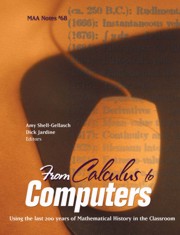Book contents
- Frontmatter
- Preface
- Contents
- Introduction
- I Algebra, Number Theory, Calculus, and Dynamical Systems
- II Geometry
- III Discrete Mathematics, Computer Science, Numerical Methods, Logic, and Statistics
- 9 Using 20th Century History in a Combinatorics and Graph Theory Class
- 10 Public Key Cryptography
- 11 Introducing Logic via Turing Machines
- 12 From Hilbert's Program to Computer Programming
- 13 From the Tree Method in Modern Logic to the Beginning of Automated Theorem Proving
- 14 Numerical Methods History Projects
- 15 Foundations of Statistics in American Textbooks: Probability and Pedagogy in Historical Context
- IV History of Mathematics and Pedagogy
- About the Authors
13 - From the Tree Method in Modern Logic to the Beginning of Automated Theorem Proving
from III - Discrete Mathematics, Computer Science, Numerical Methods, Logic, and Statistics
- Frontmatter
- Preface
- Contents
- Introduction
- I Algebra, Number Theory, Calculus, and Dynamical Systems
- II Geometry
- III Discrete Mathematics, Computer Science, Numerical Methods, Logic, and Statistics
- 9 Using 20th Century History in a Combinatorics and Graph Theory Class
- 10 Public Key Cryptography
- 11 Introducing Logic via Turing Machines
- 12 From Hilbert's Program to Computer Programming
- 13 From the Tree Method in Modern Logic to the Beginning of Automated Theorem Proving
- 14 Numerical Methods History Projects
- 15 Foundations of Statistics in American Textbooks: Probability and Pedagogy in Historical Context
- IV History of Mathematics and Pedagogy
- About the Authors
Summary
Introduction
In teaching an upper division elective course in mathematical logic for mathematics and computer science students, I have found that the class usually is divided evenly between these two groups of students, both of which suffer from insufficient experience in proving theorems. To remedy this insufficiency, I have chosen as the engine for the first part of the course a proof technique known as the tree method, an intuitively appealing and relatively simple approach for establishing the validity of arguments that works for a large subset of first order logic whose roots go back to the early part of the twentieth century. This method provides students with the opportunity to develop several important technical skills such as deriving conclusions from premises, exposing the inconsistency of a set of statements, and determining if an argument is sound. That the method became a crucial step in the development of automated theorem proving beginning in the 1950s serves to heighten the interest of the computer science students in the class, the group that needs to be even more engaged in theorem proving activities to provide the tools for constructing complex computer programs. What most distinguishes this course is that I present the method and its historical context so that the topics and their emergence are tightly coupled.
To facilitate this approach, I will present both the development of increasingly more sophisticated trees together with the relevant historical topics so that an instructor who adopts this approach using logic to teach the skills to prove mathematical theorems can choose just how much history to incorporate.
- Type
- Chapter
- Information
- From Calculus to ComputersUsing the Last 200 Years of Mathematics History in the Classroom, pp. 149 - 160Publisher: Mathematical Association of AmericaPrint publication year: 2005
- 5
- Cited by



